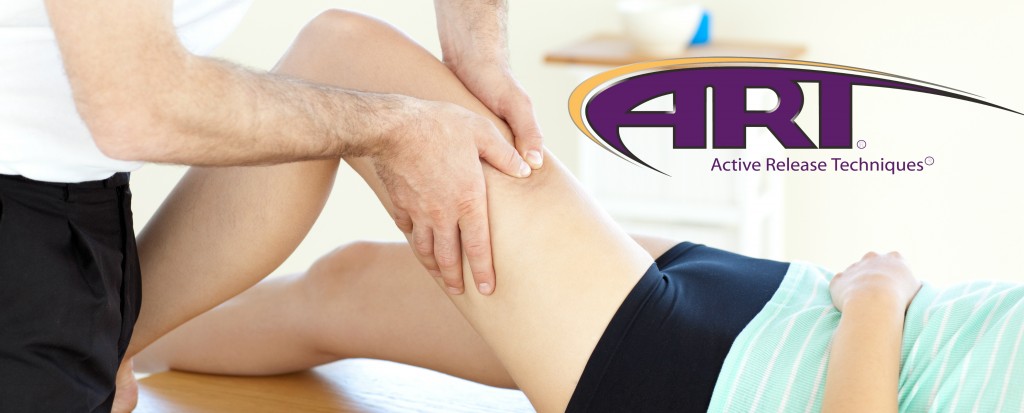
Active Release Technique (ART) is a patented soft tissue mobilization technique that addresses dysfunction of the soft tissue in the body, including muscles, tendons, ligaments, nerves and fascia. The ART practitioner uses his or her hands to palpate abnormal tissue, and using compression and tension applied manually (with the hands), moves the patient’s body in specific movement patterns to allow stretching or gliding to occur at a targeted tissue. Generally, the goal of treatment is to allow tissue that may be adhered or shortened to move freely or achieve its normal length or resting tension.
ART is taught through a series of multi-day courses, addressing various regions of the body, tissues and techniques. Currently, there are over 500 different techniques, or protocols, that are taught in the various ART courses. In order for an individual to legally perform ART, they are required to attend sanctioned ART courses, pass hands-on examination during the course(s), and maintain continuing education by participating in ART functions or courses on a yearly basis.
Comparing Other Soft Tissue Techniques
Many people ask how ART differs from other soft tissue techniques or massage practiced by healthcare professionals or massage therapists. The best answer I have is that ART, unlike many soft tissue techniques, targets specific tissues and structures, or potentially the movement of various tissues in relation to one another. In this manner, the skilled ART practitioner is able to quickly and effectively treat abnormal tissue, resolving pain and potentially abnormal mechanics or body movements.
Having treated orthopedic based patients and athletes for over 20 years, ART has fundamentally changed the manner and success in which I treat individuals today. Although not a “cure-all”, ART is an incredibly valuable tool that I use to decrease pain and restore function in my patients. Below, I’ve included a few examples of types of patients that frequently demonstrate significant improvement following treatment with ART.
Post-Ankle Sprain
Lateral, or inversion ankle sprains, are a very common injury of the lower leg, typically affecting athletes who participate in any sport involving jumping, twisting or pivoting. The typical scenario for the athlete experiencing this type of an injury is pain at either the inside (medial) or outside (lateral) aspect of the ankle, stiffness, and limited ability to run, squat or jump. In many of these patients, stiffness at the ankle limits the ability for the ankle to dorsiflex, or bend upward (toes toward the nose). Dorsiflexion range of motion (ROM) loss will result in limited ability to walk normally or squat to a normal depth. Loss of ankle dorsiflexion has also been shown to be a risk factor for predisposing athletes to other lower extremity injuries, in theory due to altered biomechanics (how the individual moves his or her body). By using ART to target specific ligaments or fascial structures (usually at the posterior, or rear aspect of the ankle), increased mobility and normal ROM of the ankle can be restored fairly quickly. Frequently, I have seen patients w/ significant restricted ability to walk or squat regain their normal mobility within a few visits with the use of ART, allowing a much quicker and safer return to sport.
Radicular Pain, or Post-Laminectomy Syndrome
Radicular pain, or post-laminectomy syndrome – Radicular pain, or pain radiating along the path of a nerve root down the leg (often referred to as “sciatica”) or arm, results when a nerve at the low back or neck has been irritated. Common causes of radiculopathy are disc injuries, where the nerve is physically being compressed by the protruding or displaced disc material, or by a condition known as stenosis, where the opening for the nerve as it exits the spine has narrowed, again resulting in compression of the nerve. Either of these conditions can create inflammation and damage to the nerve, creating a situation where the nerve is much more sensitive to being pinched (compression) or stretched (tension) anywhere along its descending pathway. Several studies have shown that regions along the path of the irritated nerve can also demonstrate increased connective tissue laydown, or fibrosis. This increased fibrosis, or scarring, can further aggravate nerve tissue by restricting the normal mobility, or translation, of the nerve. Post-laminectomy syndrome often involves patients who have undergone surgical treatment for a damaged disc, removing the damaged disc material (discectomy) and surrounding impinging bony tissue (laminectomy). Although surgical treatment has been successful in relieving pressure from the nerve at the spine, the patient will often have residual leg (or arm) pain, especially when the nerve is placed in a position of stretch. Using ART, normal translation of the nerve can be achieved by allowing the nerve to glide more freely through or around other structures, for example, the sciatic nerve as it passes the piriformis muscle at the posterior hip/buttock region.
These are just two examples of conditions that are often successfully treated using Active Release Technique. Other common ailments that I frequently treat using ART include patellofemoral syndrome (anterior knee pain), shoulder impingement syndrome (“bursitis” or strain of the shoulder), lateral epicondylitis (“tennis elbow”) and low back and neck pain. As mentioned previously, ART is not a “cure-all”, but I have found it to be a tremendously effective tool to help reduce pain and restore function in numerous patients. In the hands of a skilled and experienced healthcare provider, ART can be a “game-changer” in management of the vast majority of orthopedic conditions.
References:
Malliaras, P, et al. “Reduced ankle dorsiflexion range may increase the risk of patellar tendon injury among volleyball players”. Journal of Science and Medicine in Sport. 2006, (9) 304-309
Gobbele, R, et al. “S1 Radiculopathy as a possible predisposing factor in focal myositis with unilateral hypertrophy of the calf muscles”. Journal of the Neurologic Sciences. 1999, (170) 64-68.

